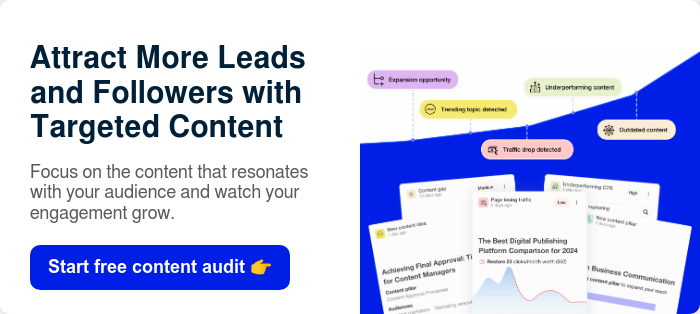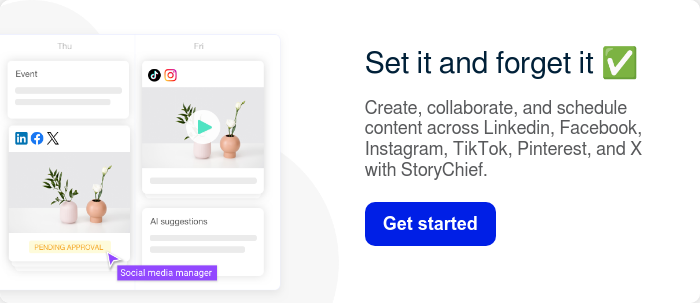LinkedIn is easily the first social media platform that comes to mind for B2B businesses. Not only is it the best place for recruitment and professional networking, but it’s also the go-to platform for lead generation. In fact, 89% of B2B marketers already use LinkedIn for lead generation.
Plus, compared to other popular lead generation platforms like Facebook and Twitter/X, LinkedIn has a 277% higher lead conversion rate.
If you have a LinkedIn account but haven’t used it for lead generation, this is a sign to start now.
Understanding LinkedIn for B2B Lead Generation
LinkedIn is a business- and employment-focused platform unlike other social media platforms created mainly for casual networking and entertainment purposes. This means its content is highly targeted and specialized for a professional audience.
You’ll find everyone from your young professionals to C-suite leaders, 20% of whom can make purchase decisions for their respective companies. Here’s why LinkedIn is the best tool for lead generation:
- A huge chunk of sales leads from social media are generated through Linkedin.
- Conversion rates are generally higher than other social media platforms and ad solutions.
- The platform allows you to set highly specific targeting parameters and advanced search filters. For example, you can list your target audience's job title, company name, seniority, location, and industry.
- It has built-in tools for lead generation (such as LinkedIn lead gen forms), making it easy to set up campaigns or integrate lead capture forms onto your profile.
Setting Up for Success: Personal Pages vs. Company Pages
As a B2B marketer, you’ll have to ensure both your personal LinkedIn profile and your company’s profile are optimized for generating leads.
Optimize your personal LinkedIn profile

Your personal LinkedIn profile is important because this is what you’ll use to engage and interact with your target customers. Unlike other social media platforms, you can’t use your company page to send direct messages to users, which is a crucial step in generating leads.
If you’re an employee, you may also consider optimizing the profiles of your company’s CEO or Sales Director.
B2B lead generation through LinkedIn may be a bit more personal than lead generation through other platforms since human interaction and relationship building are highly valued. You can’t achieve this with a company profile alone.
Optimizing your personal LinkedIn profile requires:
- Ensuring you have a clear profile photo
- Having a background photo that doesn’t just complement the profile photo but also captures your target audience’s attention
- Adding a headline that explains what you do beyond your job title
- Telling your story in the summary portion
- Growing your network and adding relevant leads
Company Page Optimization

Your personal LinkedIn page should indicate where you work. This means that leads you interact with on your personal page are likely to land on your company page. Here’s how to optimize it for lead generation:
- Use high-quality images for your profile and background photos
- Tell your brand story and what sets you apart, including the services and products you offer
- Post regular updates and content to stay on the algorithm and prove that your page is worth following
- Add a lead generation form to your profile
Take a look at the Greenhouse Software LinkedIn profile above. Its overview clearly describes what the company offers, along with valuable information that can immediately capture a lead's attention.
Tips, Tricks, and Tools for B2B Lead Generation on LinkedIn
1. Prioritize Content Marketing
Simply posting valuable content such as articles, industry news, company updates, and infographics on your page can help you generate more leads on LinkedIn.
Like in any other social media platform, consistently posting high-quality content makes your page appear more often on your audience’s feeds, making it easier for leads to find you.
The more you post, the higher the chance of engagement. Whenever a lead engages with your post, your content may appear on the feeds of your lead’s network.
Your LinkedIn content can also be bite-sized versions of lead magnets such as case studies or newsletters.

Product discovery and launch platform Product Hunt regularly posts educational content on its LinkedIn page. These types of content help boost your lead-generation strategy while nurturing existing leads.
It’s important to note that Product Hunt’s Head of Growth is also very active on the platform. This highlights the importance of using your personal LinkedIn profile to generate leads and boost your credibility.
2. Networking and Building Connections
LinkedIn is, first and foremost, a professional networking platform. The best way to generate leads is to use it for what it was made for: connecting with the right contacts, understanding their needs, and building relationships with them.
The best thing about networking on LinkedIn is that it’s unlike cold calling or cold emailing because through each other’s profiles, you already somehow know about each other. Plus, since everyone on LinkedIn knows it’s for professional networking, your attempts to connect won’t feel like spam.
Through the relationships you build, you can collect valuable referrals and opportunities to grow your prospect list. And remember that you can reward your partners with different company swag ideas to build deeper connections with them while expanding your reach.
3. Participate in LinkedIn Groups
One of LinkedIn's most helpful yet underrated features for lead generation is LinkedIn Groups. Through LinkedIn Groups, you can find leads from specific industries and niches and engage with them in a more organic setting.
Like the more popular Facebook Groups, LinkedIn Groups are made for like-minded individuals to gather, discuss, and share insights related to their interests. Being part of a LinkedIn Group immediately connects you to your ideal customer.
Groups give you a platform to share your product and services with an engaged and interested audience.
For instance, if your business is in the travel niche, you can join these LinkedIn groups:

Pro-tip: Don’t go hard-sell on your product immediately. When you’re new to a group, it’s important to know how it works and understand what type of posts get the most engagement. This will help you craft the best approach.
4. Use LinkedIn InMail
LinkedIn’s InMail is the platform’s version of DMs, making it easier to nurture leads and build relationships with them without having their emails or contact numbers.
The InMail feature allows you to send messages to leads even if you’re not yet connected to them. However, LinkedIn InMails are only available to premium members, while free members are charged a fee for every InMail sent.
Just like sending prospecting emails, you must ensure you don’t come across as too sales-y or generic. Here’s how:
- Use a compelling subject line - You can lead with something you learned about the contact, such as a promotion or a mutual friend.
- Always personalize - The potential lead likely receives dozens of messages from strangers every day, so personalized messages will help you stand out. You can mention a blog that they posted or anything relevant about them to show that you did your research.
- Keep it short - Your leads are busy professionals. They won’t have time to read long pitches. Personalize it but get straight to the point; the nitty-gritty details can be communicated later on.
5. Leverage LinkedIn Sales Navigator and Ad Tools

LinkedIn Sales Navigator is built specifically for B2B sales teams, enabling teams to build relationships and effectively track and engage leads. With Sales Navigator, you can:
- Target your ideal audience and businesses
- Track leads, including profile updates such as promotions and career movements, helping you stay on top of opportunities and make strategic offers.
- Build lists and share notes across team members so everyone is aligned.
To ensure your profile and content are visible beyond your current connections, it’s also important to utilize the platform's advertising tools. You can run lead-generation LinkedIn ads, which come with pre-filled forms, allowing you to collect quality leads seamlessly.
Lead gen ads are designed to connect leads to relevant content. After submitting a form, you can connect them to nurturing content such as case studies, eBooks, or any of your channels. Additionally, LinkedIn gives you the option to add a lead gen form so you can capture those who land on your page organically.
6. Build your Credibility with LinkedIn Pulse
LinkedIn Pulse is the platform’s publishing platform that enables you to post your articles and reach a wider audience. Having articles on Pulse can boost your credibility and get your business in front of relevant users.
One of the valuable features of LinkedIn Pulse is providing detailed analytics, including a list of people who viewed your article and the amount of time they spent on it. This information can help you identify possible leads and guide your content marketing strategy.
Your connections will be notified every time your article gets published on Pulse, while the algorithm will suggest your content to users outside your network.
With SEO best practices and strategic keywords, your Pulse article can also rank on search.
Conclusion
LinkedIn gives you a wealth of information about your target audience you can use to create an effective lead generation strategy. More importantly, as a professional platform, you won’t have to compete against too many variables compared to more casual platforms like on Facebook or Instagram.
Use these tips to help you generate more leads and use the platform to its full potential.







